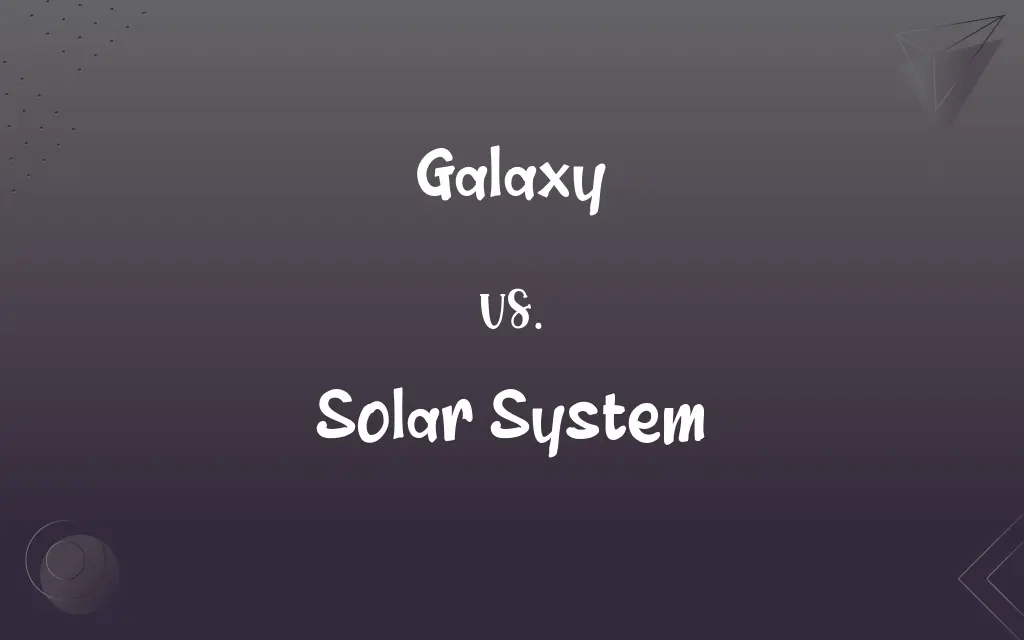Galaxy vs. Solar System: What's the Difference?
Edited by Harlon Moss || By Janet White || Published on December 3, 2023
A galaxy is a vast collection of stars, dust, and gas held together by gravity, spanning millions of light-years, while a solar system is a group of planets and other celestial bodies orbiting a single star.

Key Differences
A galaxy is an enormous system composed of stars, stellar remnants, interstellar gas, dust, and dark matter, all bound together by gravity. It can contain billions of stars and extend over thousands of light-years. In contrast, a solar system is much smaller, typically encompassing a single star and the celestial bodies gravitating around it, including planets, asteroids, and comets. The solar system's scale is limited to the star's gravitational influence.
The structure of a galaxy varies, ranging from spiral to elliptical and irregular shapes. Galaxies are classified based on their appearance and composition. Solar systems, however, have a more uniform structure, generally featuring a central star with orbiting planets, which may have their own moons, and various smaller bodies like asteroids and comets. The organization within a solar system is dictated by the gravitational pull of its central star.
Galaxies are vast and separated from each other by immense intergalactic spaces, often millions of light-years apart. Within a galaxy, solar systems are just tiny components. The solar system, specifically referring to our own, is part of the Milky Way galaxy, illustrating the scale difference between these two astronomical entities.
The formation of galaxies involves the gravitational collapse of a large cloud of gas and dust, leading to the creation of numerous stars. The solar system's formation, on the other hand, is believed to have resulted from a similar process but on a much smaller scale, where a cloud of gas and dust collapsed to form the Sun and the rest of the solar system bodies.
In terms of exploration and study, galaxies are observed and analyzed using advanced telescopes and astrophysical methods, as their vast distances make direct exploration currently impossible. Solar systems, particularly our own, are studied through a combination of telescopic observation and direct exploration by spacecraft, providing a more detailed and hands-on understanding of their composition and dynamics.
ADVERTISEMENT
Comparison Chart
Size
Comprises millions to trillions of stars.
Contains one star and its orbiting bodies.
Structure
Varies from spiral, elliptical to irregular.
Typically features a central star with orbiting planets.
Scale
Measured in thousands to millions of light-years.
Extends over a few billion miles.
Formation
Formed from large clouds of gas and dust.
Formed from a smaller cloud of gas and dust.
Exploration
Studied through telescopes, not physically reachable.
Studied through both telescopes and spacecraft.
ADVERTISEMENT
Galaxy and Solar System Definitions
Galaxy
A massive, gravitationally bound system consisting of stars, stellar remnants, interstellar gas, and dark matter.
The Milky Way is a spiral galaxy that contains our solar system.
Solar System
A star and all the objects that travel in orbit around it, including planets, moons, asteroids, and comets.
Our solar system includes eight planets, with Earth being the third from the Sun.
Galaxy
A large-scale assembly of stars, often numbering in the billions, that can also contain various other astronomical objects.
Astronomers discovered a new galaxy that challenges existing theories of galaxy formation.
Solar System
The region of space occupied by a star and its accompanying planets, asteroids, comets, and other bodies.
The Voyager spacecraft have sent back valuable data about the outer regions of our solar system.
Galaxy
A term used to describe a collection of stars and associated matter connected by gravity, visible as a distinct entity in space.
Through a telescope, you can see the Andromeda Galaxy, our closest galactic neighbor.
Solar System
A star's planetary system, including all the natural bodies that orbit it.
The discovery of exoplanets has expanded our knowledge of solar systems beyond our own.
Galaxy
An astronomical unit of space that encompasses vast interstellar expanses, star systems, and nebulae.
The Hubble Space Telescope has captured stunning images of distant galaxies.
Solar System
A gravitational system centered around a star, with various bodies orbiting it.
Scientists continually study the solar system to understand more about its formation and evolution.
Galaxy
In a broader sense, any large and coherent star system with a common gravitational center.
The discovery of galaxies beyond the Milky Way revolutionized our understanding of the universe.
Solar System
The collection of celestial bodies, including a central star and its planetary system, held together by gravity.
The solar system is a tiny part of the Milky Way galaxy.
Galaxy
Any of numerous large-scale aggregates of stars, gas, and dust that constitute the universe, containing an average of 100 billion (1011) solar masses and ranging in diameter from 1,500 to 300,000 light-years.
Galaxy
Often Galaxy The Milky Way.
FAQs
What constitutes a solar system?
A solar system consists of a star and all the objects that orbit it, including planets, moons, and smaller bodies.
What is the closest galaxy to our solar system?
The closest galaxy to our solar system is the Andromeda Galaxy.
What is a galaxy?
A galaxy is a massive system of stars, interstellar gas, dust, and dark matter, bound together by gravity.
Can a solar system exist outside of a galaxy?
Solar systems typically exist within galaxies, as they form from the same interstellar material.
How are new galaxies discovered?
New galaxies are discovered through telescopic observation and advanced astronomical techniques.
How big is a galaxy compared to a solar system?
A galaxy is immensely larger than a solar system, often spanning thousands to millions of light-years.
Are all galaxies the same shape?
No, galaxies come in various shapes, including spiral, elliptical, and irregular.
What is the largest galaxy known?
The largest known galaxy is IC 1101, which is several million light-years across.
Is our solar system moving within the galaxy?
Yes, our solar system orbits the center of the Milky Way galaxy.
How many planets are in our solar system?
There are eight known planets in our solar system.
How do we study our solar system?
Our solar system is studied through telescopic observations and space missions.
What defines the boundary of a solar system?
The boundary of a solar system is often defined by the extent of the star's gravitational influence.
What is the center of a galaxy?
The center of a galaxy is often occupied by a supermassive black hole or a dense cluster of stars.
Can galaxies collide?
Yes, galaxies can collide and merge over billions of years.
How many solar systems are in a galaxy?
A galaxy can contain millions to billions of solar systems.
Can planets exist outside of a solar system?
Yes, rogue planets can exist outside of a solar system, not orbiting any star.
What is the role of gravity in a solar system?
Gravity keeps the planets and other bodies in orbit around the central star in a solar system.
What is a dwarf galaxy?
A dwarf galaxy is a small galaxy composed of up to several billion stars, smaller than typical galaxies.
How old is our solar system?
Our solar system is about 4.6 billion years old.
What is the significance of studying galaxies?
Studying galaxies helps us understand the universe's formation, evolution, and large-scale structure.
About Author
Written by
Janet WhiteJanet White has been an esteemed writer and blogger for Difference Wiki. Holding a Master's degree in Science and Medical Journalism from the prestigious Boston University, she has consistently demonstrated her expertise and passion for her field. When she's not immersed in her work, Janet relishes her time exercising, delving into a good book, and cherishing moments with friends and family.
Edited by
Harlon MossHarlon is a seasoned quality moderator and accomplished content writer for Difference Wiki. An alumnus of the prestigious University of California, he earned his degree in Computer Science. Leveraging his academic background, Harlon brings a meticulous and informed perspective to his work, ensuring content accuracy and excellence.






































































